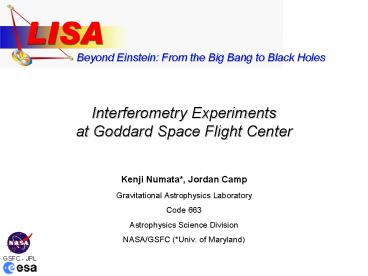Interferometry Experiments at Goddard Space Flight Center PowerPoint PPT Presentation
1 / 16
Title: Interferometry Experiments at Goddard Space Flight Center
1
Interferometry Experiments at Goddard Space
Flight Center
- Kenji Numata, Jordan Camp
- Gravitational Astrophysics Laboratory
- Code 663
- Astrophysics Science Division
- NASA/GSFC (Univ. of Maryland)
2
1. Iodine laser stabilization
- Iodine meets LISA frequency noise requirements
- Provides absolute reference frequency (/- 300
Hz) - System does not need temperature stabilization
- Frequency tunable as is
- System simplification is possible 1 or no
modulators - Concern raised at last WG meeting distortion of
main beam through frequency doubling crystal
3
Iodine laser stabilization
- New type of doubling crystal now available from
AdvR Periodically poled lithium niobate
waveguide - High doubling efficiency 1 mW green output for
100 mW IR input - So we can use 100 mW picked off from main beam to
go through waveguide for generation of green
light - Main beam suffers no distortion!
- Iodine has many attractive features as back-up
technology - Raise your hand if you believe.
4
2. Suspension Point Interferometer
- Concept active low-frequency environment
stabilization - Stabilized metrology
- Stabilization interferometer measures
environmental relative motion. - Signal is fed back to actuator (Hexapod
controlled by PZTs). - Measurement interferometer measures stability of
components (interferometer itself) - Outside-of-loop measurement
- Both interferometers use molecular iodine as
frequency reference
5
Optical Configuration
- Metrology interferometer
- 2 stabilization beams
- Length yaw (rotation)
- 1 measurement beam
- Homodyne Michelson
- Retro-reflectors for easier alignment robustness
6
Photographs
- Main components
- Laser with iodine frequency reference
- Monolithic silicate-bonded optics
- Hexapod
- Distance between hexapods 1m
- Digital control system
- 2-DoF control (length yaw)
7
Stabilization Result
- Current system performance in frequency spectrum
- Free-running
- 1um/rtHz _at_1mHz level (over 1m / identical
optical table / vacuum) - Stabilized
- Gain 500 achieved
- Satisfies 30pm/rtHz above 10mHz
8
Identifying Noise Sources
- In progress
- Interferometer (sensor) noise
- Evaluated on single optical bench
- Electronic noise
- Small contributions
9
Monolithic Test Interferometer
- Test on single optical bench
- Same readout scheme to evaluate noises
- 0.1nm/rtHz at 1mHz
- Limited by unidentified noises --- beam pointing
noise? - Upper limit of stability of ULE bench, mirrors
- 1nm/rtHz at 1mHz with two controlled optical
benches - Further improvements should be possible in
2-bench configuration.
10
Other Possible Noises
- Beam pointing
- Stable fiber launcher required
- Coupling from uncontrolled degree of freedom
- Other DoFs to be controlled
SIM beam launcher
LISA pathfinder beam launcher
11
DMI Test
- Calibration of commercial interferometer (DMI by
Zygo) - Planned to be used in JWST mirror testing
- Question
- How stable/sensitive is DMI over long path length
time scales? - Our system provides stable environment
- To evaluate DMI
Work done with Dr. Anthony Yu (Code 554)
12
DMI Experiment
- DMI mounting to ULE base
- No relative drift allowed
- DMI requires screw threads for mounting
- Polished invar piece as a spacer
- ltLambda/4 level polish (done by Cumberland
Optics) - Silicate-bonded to ULE
- Most stable glass-metal bonding method
- Displacement noise level ltpm/rtHz
- No alignment possible once fixed
- Vacuum
- DMI was put inside vacuum tank.
- Eliminates noises associated with air
13
Results
- Still under progress
- In frequency domain
- 10 times worse than our system
- 10nm/rtHz _at_ 1mHz
- In time domain
- Drift rate 4nm/hour (temperature dependent)
These data were taken with 1m path length.
14
5. Future Works
- Upgrades (short term)
- Achieving LISA requirements and better DMI
evaluations - Several remaining issues
- Direct measurement of DMIs frequency noise
(drift) using 2 DMIs. - Adding other DoF control
- Pitch might be coupled to DMI measurement
through beam height difference. - Compact monolithic fiber launcher
- Removal of unstable commercial mounts
- Heterodyne system
- Provides unlimited locking points, actuation
range, robustness, and flexibility - Current homodyne system actuation range lt 0.5um
- Longer path length with 2 separated tables
- Imitates realistic measurement environments
15
Other Application
- Phasemeter testing for LISA
- LISAs main output heterodyne interferometer
with phasemeter - Microradian phase variation due to gravitational
wave - Response, stability, and linearity of phasemeter
- Space-like stable environment
- Known signal injection
- Stability test of other LISA optical components
- Ex.) Angle actuators
16
Summary
- Testbed to enable stabilized metrology
- Stability between optical benches (components) is
crucial. - Thermal/seismic drifts obscure main measurement.
- LISA pm level stability between two benches
- Other missions main mirror metrology, secondary
mirror adjustment, etc. - Suppression of environmental motion
- Sub-nanometer stability over 1000 seconds
(gain500) - Reaching LISA requirements
- Scalable applicable to other advanced telescope
mission - Application example of stable environment DMI
stability test - Few nm/hour drift in a standard lab environment
over 1m. - Suppression of near DC drift to nm level is very
hard!

